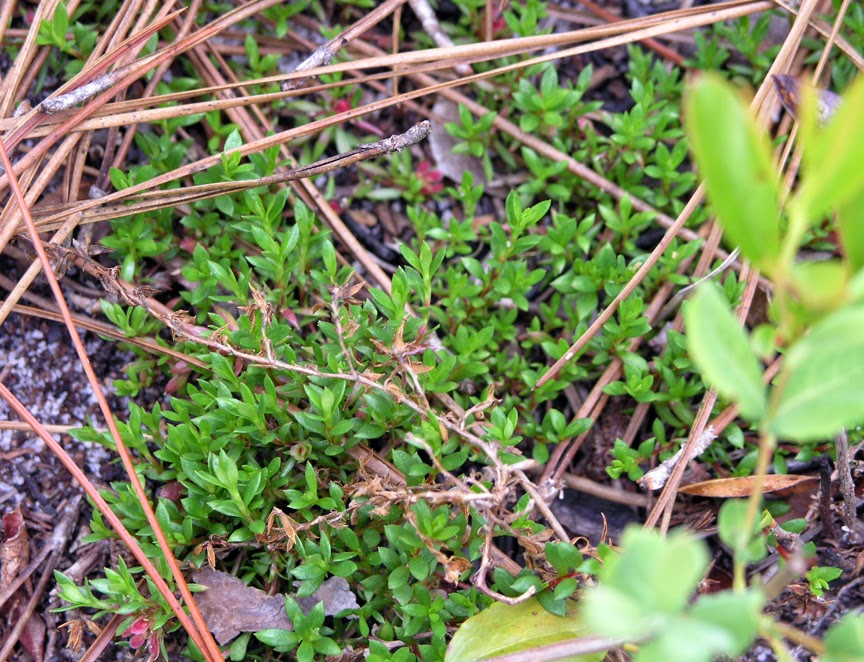 |
| Lake Waccamaw State Park rangers guide the NCNPS group. |
The following morning the North Carolina Native Plant Society (NCNPS) group met at Lake Waccamaw State Park for a tour of the trails surrounding the Visitor's Center. Covering 36 acres, Lake Waccamaw is the largest of North Carolina's "bay lakes," a term for this type of oval-shaped fresh water lakes. On Friday evening, the Head ranger had given the group a talk describing some of the theories about the formation of these unusual lakes that occur in certain regions along the eastern seaboard. I remembered reading one theory in a National Geographic article years ago about a prehistoric meteor strike leaving these craters which later filled with water and developed certain type of ecosystems, but evidently this theory has now been dismissed as unlikely. The most plausible theory seems to be that the lakes formed as a result of a combination of the massive land and ocean processes that took place during the Pleistocene era, when this area was submerged. The lakes in this area all seem to have a high limestone shelf on their northwestern rims and sandy shores on the southeastern portions, and three varieties of bay trees predominate: sweet bay, red bay and loblolly bay.
 |
| Loblolly bay (Gordonia lasianthus), the leaves have crenulate edges. |
As we began our walk, the Rangers explained that the park had recently begun to use managed burns to control the undergrowth and try to restore native habitats. The fire doesn't damage the established trees, and improves the overall health of the forest, but the rangers were of the opinion that a successful controlled burn is very much an art, and the precise weather conditions need to be taken into account if the fire is not to get out of control.
 |
| Prickly pear (Opuntia humifusia) growing among bracken ferns. |
 |
| Pink spiderwort (Trandescantia virginiana) |
I was surprised to see Prickly Pear blooming among the bracken ferns near the Visitor's Center, and was assured that these cacti are actually native to the entire east coast from Florida to Connecticut--I had always thought they had been introduced from the southwest and naturalized. We also came across a lovely pink-flowered Spiderwort --I've only seen the blue Spiderwort (Trandescantia virginiana) before.
 |
| Fetterbush (Lyonia lucida) growing under turkey oaks. |
 |
| Honeybells (Zenobia pulverulenta) with Fetterbush in back. |
The forest floor was carpeted with bracken and other ferns. Flowering native bushes such as Fetterbush (Lyonia lucida) with small pinkish bells and the sweetly scented Honeybells (Zenobia pulverulenta) bloomed below the shelter of the turkey oaks. I spotted a tiny-leaved plant on the forest floor and was told this was Pixie Moss (Pyxidanthera barbulata)--it could make a lovely ground cover in the right garden.
 |
| Pixie Moss (Pyxidanthera barbulata) |
All these were a completely new community of plants to me, a fascinating environment to be introduced to. There were also many birds here: a number of warblers, mocking birds, and brown thrashers were spotted by the bird-savvy among the group.
The time for our departure came much too soon--Linda and I needed to start our 7-hour trip back by noon in order to get home at a decent hour, so we said goodbye to our new-found friends in NC around eleven and started walking back to our car. One lone wild turkey crossed our path, and Linda lingered to identify an indigo bunting along the way.
I wished we could have stayed one more day--despite our precautions, we still encountered a huge backup on I-95 after we passed Richmond this Sunday evening, and spent almost an hour fighting the traffic to reach our exit. The sun was just setting on this beautiful spring day as we returned to the Shenandoah Valley.
 |
| The forest at Lake Waccamaw. |
For more photos of our walk at Lake Waccamaw State Park and the Green Swamp see my Flickr album here.